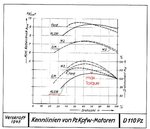Not really, it's a general comment. As I said there are more sections dealing with these problems. No HL 230 developed 700CV. Nominal value was 690CV but this was at max regime (3000rpm). Risk of fire was just too high and reduced to 2500rpm. This would give 600CV, not very healthy for a 70 ton tank. Read Jentz:
Maximum speed for the Tiger-I decreased to 37.8km/h and for the Tiger-II to 34.6km/h after November 1943 when HL 230 motor was regulated not to exceed 2500rpm.
Tiger-I and II combat tactics, by Jentz
The HL230 P30 developed 700 PS (European horsepower) at 3,000 rpm (equal to 690 bhp), later a governor was put on which wouldn't allow rpms to exceed 2,500 rpm. This was done not because of a risk of fire, but simply to increase engine life as the Germans knew that regular maintenance would be hard to achieve in the situation they were currently placed.
But contrary to what you incorrectly claim this reduction in max permissable rpm had no effect on the tank's mobility at all, which is also explained by Jentz (Do you even read what he writes??). The max torque (1,850 Nm) of the HL230 engine being developed at 2,100 rpm.
The Tiger values are simply wrong.
No they aren't, they are exactly right and from Jentz.
Not really, Jentz trilogy on Tiger is far better.
Don't you get it?? The info on that site IS from Jentz! I have the books, I know, much of what is written on the site is directly copied from works by Jentz!
Anyway, Tigers were operated in independent battalions because they demanded much more maintenance and were far more complicated than other tanks used in Panzer divisions. As mkenny pointed out (excellent message), availability was higher very often because Tigers saw less combat. Some more information.
Soldiers of the fuel section of the battalion during a formation. These soldiers were kept very busy satisfying the "thirst" of a Tiger [I}, which consumed 500 liters of fuel for every 500 kilometers of cross country movement. (Pag 219)
By the way, that value 500 litres/ 500 kms is what the Russians measured in Kubinka.
And here's what is listed in the German manual (Again provided by Jentz):
Fuel capacity: 860 Liters
Range Cross country: 80 km
Range on road: 170 to 120 km
That translates into a fuel consupmtion cross country of 10.75 L/km, which is more than 500 Liters pr. 500 km as that simply enough tranlates into 10 L/km. So here we see that the German specs are once more actually quite conservative compared to the real performance.
Anything else you'd like to come up with?
Finally, some information on quality:
"IS-2 vehicles, most likely from the 13th Heavy Tank Regiment, skirmished with the Tigers from 424 sHPzAbt near Lisow. The advancing Tigers were greeted by powerful and accurate fire from tanks and ant-tank weapons. The armor, made from lower quality steel (due to problems with raw materials) could not withstand the 122mm, 25 kilogram projectiles and the attack broke down. The battalion commander, Major Saemisch was killed and numerous tanks were lost."
Kielce 1945" by Norbert Baczyk.
You must be joking! The Tigers lost near Lisow were taking out from the flanks after having been poorly commanded into a very disadvantagous situation, getting bogged down in the swamps surrounding the town of Lisow. The quality of the Tiger's armour had nothing to do with the outcome of that battle, the stupid tactics employed by the commander of those tanks however had everything to do with it. But besides this one of the company's tanks commanded by Lt. Oberbracht managed to knock out 7 Soviet tanks in his bogged down outflanked Tiger II in that battle, having earlier in the same day destroyed another 12 Soviet tanks.
From Tigers in Combat by Wolfgang Schneider:
"On the march to Lisow, Tiger 323 breaks through a 12 ton bridge. The battalion launches the assault with the first company on the left, the third company on the right and the second company following. Several tanks are bogged down in the swamps beside the narrow road and cannot be recovered. On the South edge of Lisow, the Tiger 111 (Lt. Oberbracht) loses both tracks, nevertheless, it destroys 20 tanks. The second company knocks out 7 T-34s. Tigers 202 and 221 break down during the movement to contact 200 meters in front of the town. Tiger 334 stops with a broken driveshaft. In Lisow the battalion is ambushed by Josef Stalin tanks and hidden anti-tank guns, and is almost completely wiped out. The battalion commander's Tiger is also knocked out....During the retreat, Tiger 332 recovers one of the bogged down tanks of the 3rd company, but suffers a broken track tensioner a short time later and has to be blown up." "
Also just so you know it, there isn't a single incident during the war where a Tiger Ausf.B was knocked out from the front. In short no Tiger Ausf.B ever had its' frontal armour defeated in combat, of the ones lost in actual combat, which was very few, all were taken out by flanking shots from the side or rear, or from above by enemy fighter bombers. So there's your testimony to the quality of its armour.
In the west one Tiger II was taken out from the front by a shot to its belly after driving over a pile of rubble.
Last edited:

